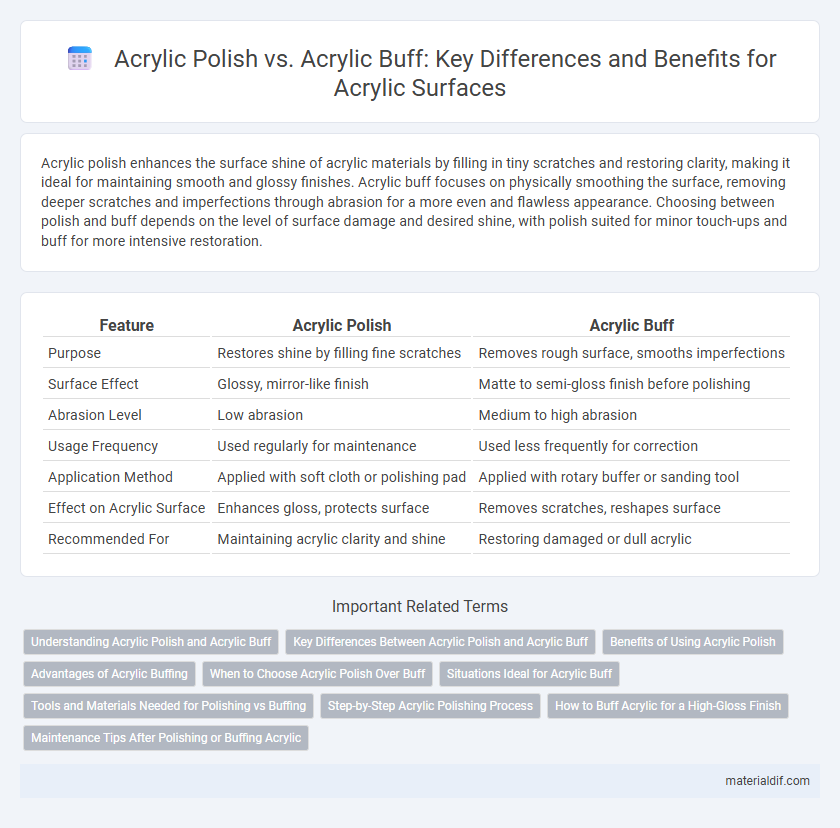Acrylic polish enhances the surface shine of acrylic materials by filling in tiny scratches and restoring clarity, making it ideal for maintaining smooth and glossy finishes. Acrylic buff focuses on physically smoothing the surface, removing deeper scratches and imperfections through abrasion for a more even and flawless appearance. Choosing between polish and buff depends on the level of surface damage and desired shine, with polish suited for minor touch-ups and buff for more intensive restoration.
Table of Comparison
| Feature | Acrylic Polish | Acrylic Buff |
|---|---|---|
| Purpose | Restores shine by filling fine scratches | Removes rough surface, smooths imperfections |
| Surface Effect | Glossy, mirror-like finish | Matte to semi-gloss finish before polishing |
| Abrasion Level | Low abrasion | Medium to high abrasion |
| Usage Frequency | Used regularly for maintenance | Used less frequently for correction |
| Application Method | Applied with soft cloth or polishing pad | Applied with rotary buffer or sanding tool |
| Effect on Acrylic Surface | Enhances gloss, protects surface | Removes scratches, reshapes surface |
| Recommended For | Maintaining acrylic clarity and shine | Restoring damaged or dull acrylic |
Understanding Acrylic Polish and Acrylic Buff
Acrylic polish is a fine abrasive compound designed to remove surface imperfections, restore shine, and smooth acrylic surfaces by gently sanding away minor scratches and oxidation. Acrylic buff, on the other hand, involves using a soft buffing pad or cloth to evenly distribute polish while enhancing the acrylic's gloss without removing much material. Understanding the difference ensures proper maintenance: polish corrects flaws and refines the surface, while buffing finalizes the finish for a high-gloss, seamless look.
Key Differences Between Acrylic Polish and Acrylic Buff
Acrylic polish is a liquid or cream product designed to restore shine and remove fine scratches from acrylic surfaces, while acrylic buff is a mechanical process that uses a rotating pad or cloth to physically smooth and enhance the acrylic's finish. The polish works chemically by filling imperfections and adding gloss, whereas buffing relies on abrasion to even out the surface texture. Choosing between polish and buff depends on the level of damage; polish suits minor blemishes, while buffing addresses deeper scratches and dullness.
Benefits of Using Acrylic Polish
Acrylic polish enhances the surface shine of acrylic materials by filling micro-scratches and restoring clarity, which prolongs the lifespan and appearance of acrylic products. It offers a protective layer that resists yellowing and environmental damage, maintaining the material's smooth and glossy finish. Compared to acrylic buff, polish provides a more precise surface treatment ideal for intricate or delicate acrylic components.
Advantages of Acrylic Buffing
Acrylic buffing enhances the surface smoothness and shine of acrylic materials by gently removing fine scratches and imperfections, resulting in a high-gloss finish that polish alone cannot achieve. Buffing extends the lifespan of acrylic surfaces by sealing micro-cracks and improving resistance to environmental wear. This technique offers a cost-effective solution for maintaining acrylic's clarity and aesthetic appeal without the need for extensive chemical treatments.
When to Choose Acrylic Polish Over Buff
Acrylic polish is ideal when aiming to restore the surface's clarity and remove minor scratches or oxidation without altering the shape or texture. Choose acrylic polish over buff when the goal is to enhance shine and smooth out imperfections on thin or delicate acrylic sheets that might be damaged by aggressive buffing. Polishing maintains the acrylic's original gloss and transparency, whereas buffing is more suitable for reshaping or heavy surface correction.
Situations Ideal for Acrylic Buff
Acrylic buffing is ideal for smoothing surface imperfections and restoring shine without removing significant acrylic material, making it perfect for maintaining nail health during regular manicures. Unlike acrylic polish, which adds color and requires full application, acrylic buff works well for quick touch-ups or preparing nails for new polish. This technique is especially effective for enhancing nail texture and extending the life of acrylic nails between salon visits.
Tools and Materials Needed for Polishing vs Buffing
Acrylic polish requires fine-grit polishing compounds, microfiber cloths, and sometimes specialized polishing pads to achieve a smooth, glossy finish without scratching the surface. Acrylic buffing utilizes rotary buffers, soft buffing pads, and buffing compounds designed to remove deeper scratches and refine the surface texture. Choosing the right tools and materials depends on the desired level of shine and condition of the acrylic, with polishing focusing on surface enhancement and buffing targeting surface correction.
Step-by-Step Acrylic Polishing Process
Acrylic polish involves applying a fine abrasive compound to smooth the surface and restore clarity, while acrylic buff uses a soft cloth or buffing wheel to enhance the shine and remove micro-scratches. The step-by-step acrylic polishing process starts with cleaning the surface, followed by applying acrylic polish evenly, and using a buffing instrument to achieve a glossy finish. This method improves durability and aesthetic appeal, making acrylic items look new and scratch-free.
How to Buff Acrylic for a High-Gloss Finish
To buff acrylic for a high-gloss finish, start by sanding the surface with fine-grit sandpaper to remove imperfections and scratches. Use a soft buffing wheel paired with a polishing compound formulated for acrylic, applying moderate pressure to enhance clarity and shine. Finish by cleaning the acrylic with a microfiber cloth to reveal a smooth, mirror-like surface that is both durable and visually appealing.
Maintenance Tips After Polishing or Buffing Acrylic
After polishing acrylic, use a soft, lint-free cloth to gently remove any residual polish and avoid applying excessive pressure that can cause micro-scratches. When buffing acrylic, maintain a low-speed setting on the buffer and use a clean, non-abrasive buffing pad to preserve the surface clarity and prevent heat buildup. Regularly clean acrylic surfaces with mild soap and water to extend the longevity of the polish or buff finish and prevent dulling caused by dust or oils.
Acrylic Polish vs Acrylic Buff Infographic

 materialdif.com
materialdif.com